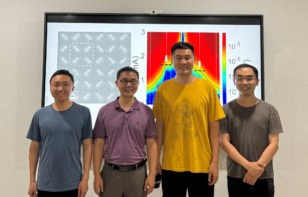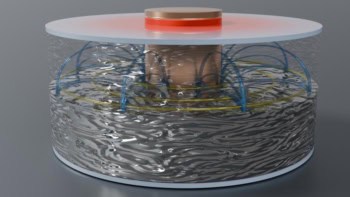The ‘proximity effect’ in superconductors is well known: when a superconductor is placed in contact with an ordinary metal, its superconductivity can be suppressed. But now physicists have demonstrated an inverse proximity effect for the first time, in which superconductivity occurs more readily in a superconductor touching a metal. Robert Dynes of the University of California at San Diego and colleagues found that the transition temperature of a superconducting lead film increased when it was coated with silver. The researchers attribute the effect to the strong links that exist between electrons in silver (O Bourgeois et al 2002 Phys. Rev. Lett. 88 186403).
Superconductors are materials that lose their electrical resistance below a certain ‘transition temperature’. In most superconductors, the current consists of electrons that have overcome their mutual repulsion to form pairs. These pairs are propelled through the material without resistance by vibrations of the crystal lattice known as phonons.
Theories of superconductivity say that the proximity effect occurs when these pairs of electrons leak from a superconductor into a metal, and single electrons flow from the metal into the superconductor. This process lowers the transition temperature of the superconductor and reduces its ‘superconducting gap’ – the energy needed to split the electron pairs. Meanwhile, the metal takes on some properties of the superconductor.
But Dynes and colleagues suspected that this effect would be reversed if a superconductor was put in contact with a metal in which the electrons are strongly bound to each other. They tested their idea by coating thin films of lead – which act as superconductors – with silver, in which electrons interact strongly with each other.
The researchers studied twelve lead films ranging in thickness from 0.9 to 3.2 nm. Samples of these films were coated with layers of silver up to 0.7 nm thick. When the team measured the transition temperatures of these films, they found that it was higher when a layer of silver was present, as they predicted. The biggest jump in the transition temperature – from below 1.6 K to over 1.9 K – was seen in a lead film 1.1 nm thick coated with a layer of silver 0.26 nm thick.
To establish whether this inverse proximity effect altered the ‘superconducting gap’ of the lead films, Dynes’ team measured the conductance of the films at 1.65 K. The researchers found that the conductance of the films fell as the silver became thicker. The largest increase in the superconducting gap was a hike of 20% – seen in a lead film 0.9 nm thick with a silver layer 0.2 nm thick – compared with a similar film with no silver coating.
According to Dynes and co-workers, these effects can be explained by the flow of strongly bound complexes of electrons – or ‘quasi-particles’ – from the silver layer into the lead film. They believe that these quasi-particles reduce the electrostatic repulsion between electrons in the superconductor, making it easier for them to pair up and contribute to the superconducting current. They also suggest that the electron pairs in the lead film are more tightly bound when the lead is thinly coated with silver.
Dynes speculates that his team’s discovery could lead to new applications for superconductor devices – such as Josephson junctions – which exploit the conventional proximity effect. High-temperature superconductors also have strongly interacting electrons, but these have not been extensively studied. Dynes says that his team plans to study these materials next.



